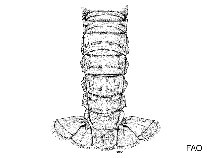Metanephrops mozambicus Macpherson, 1990
African lobster| Native range | All suitable habitat | Point map | Year 2050 |

|
| This map was computer-generated and has not yet been reviewed. |
| Metanephrops mozambicus AquaMaps Data sources: GBIF OBIS |
Classification / Names Common names | Synonyms | CoL | ITIS | WoRMS
Malacostraca | Decapoda | Nephropidae
Environment: milieu / climate zone / depth range / distribution range Ecology
Benthic; depth range 180 - 750 m (Ref. 106911), usually 400 - 500 m (Ref. 106911). Tropical, preferred 26°C (Ref. 107945); 3°S - 33°S, 31°E - 46°E (Ref. 4)
Distribution Countries | FAO areas | Ecosystems | Occurrences | Introductions
Southwest Atlantic and Indo-West Pacific: from Kenya to Natal.
Length at first maturity / Size / Weight / Age
Maturity: Lm 4.9, range 3 - ? cm Max length : 20.5 cm TL male/unsexed; (Ref. 122061); 20 cm TL (female)
It has a maximum total length of 20.5 cm (male) and 20 cm (female); and carapace lengths of 4.5 to 8.8 cm (male) and 3.7 to 8.3 (female). Minimum depth range from Ref. 122059.
Life cycle and mating behavior Maturity | Reproduction | Spawning | Eggs | Fecundity | Larvae
Ovigerous females between December and June (Ref. 4).
Main reference
References | Coordinator | Collaborators
Holthuis, L.B. 1991. (Ref. 4)
IUCN Red List Status (Ref. 130435: Version 2024-1)
Least Concern (LC) ; Date assessed: 03 December 2009
CITES status (Ref. 108899)
Not Evaluated
CMS (Ref. 116361)
Not Evaluated
Threat to humans
Human uses
Fisheries: commercial
FAO - Fisheries: landings | FishSource | Sea Around Us
Tools
More information
Trophic Ecology
Food items
Diet
Food consumption
Ration
Predators
Diet
Food consumption
Ration
Predators
Ecology
Population dynamics
Growth
Age/Size
Length-weight
Length-length
Length-frequencies
Mass conversion
Recruitment
Abundance
Age/Size
Length-weight
Length-length
Length-frequencies
Mass conversion
Recruitment
Abundance
Life cycle
Distribution
Human Related
Aquaculture profile
Stamps, Coins Misc.
Stamps, Coins Misc.
Outreach
Taxonomy
References
Internet sources
BHL | BOLD Systems | CISTI | DiscoverLife | FAO(Fisheries: ; publication : search) | Fishipedia | GenBank (genome, nucleotide) | GloBI | Gomexsi | Google Books | Google Scholar | Google | PubMed | Tree of Life | Wikipedia (Go, Search) | Zoological Record
Estimates based on models
Preferred temperature
(Ref. 115969): 10 - 12.3, mean 11.4 (based on 9 cells).
Resilience
(Ref. 69278):
High, minimum population doubling time less than 15 months (K=0.45-0.48).
Nutrients : Calcium = 109 [35, 184] mg/100g; Iron = 1.59 [1.21, 1.97] mg/100g; Protein = 20.2 [19.2, 21.3] %; Omega3 = 0.285 [0.185, 0.386] g/100g; Selenium = 48.3 [-31.7, 128.3] μg/100g; VitaminA = 0 μg/100g; Zinc = 1.79 [1.17, 2.40] mg/100g (wet weight); based on nutrient studies.



